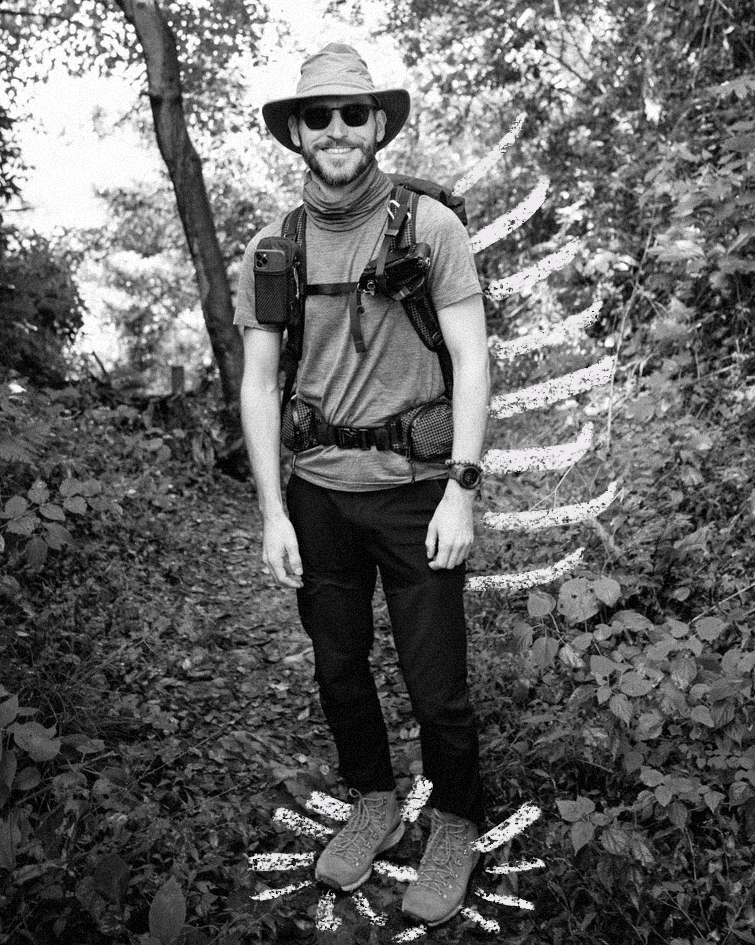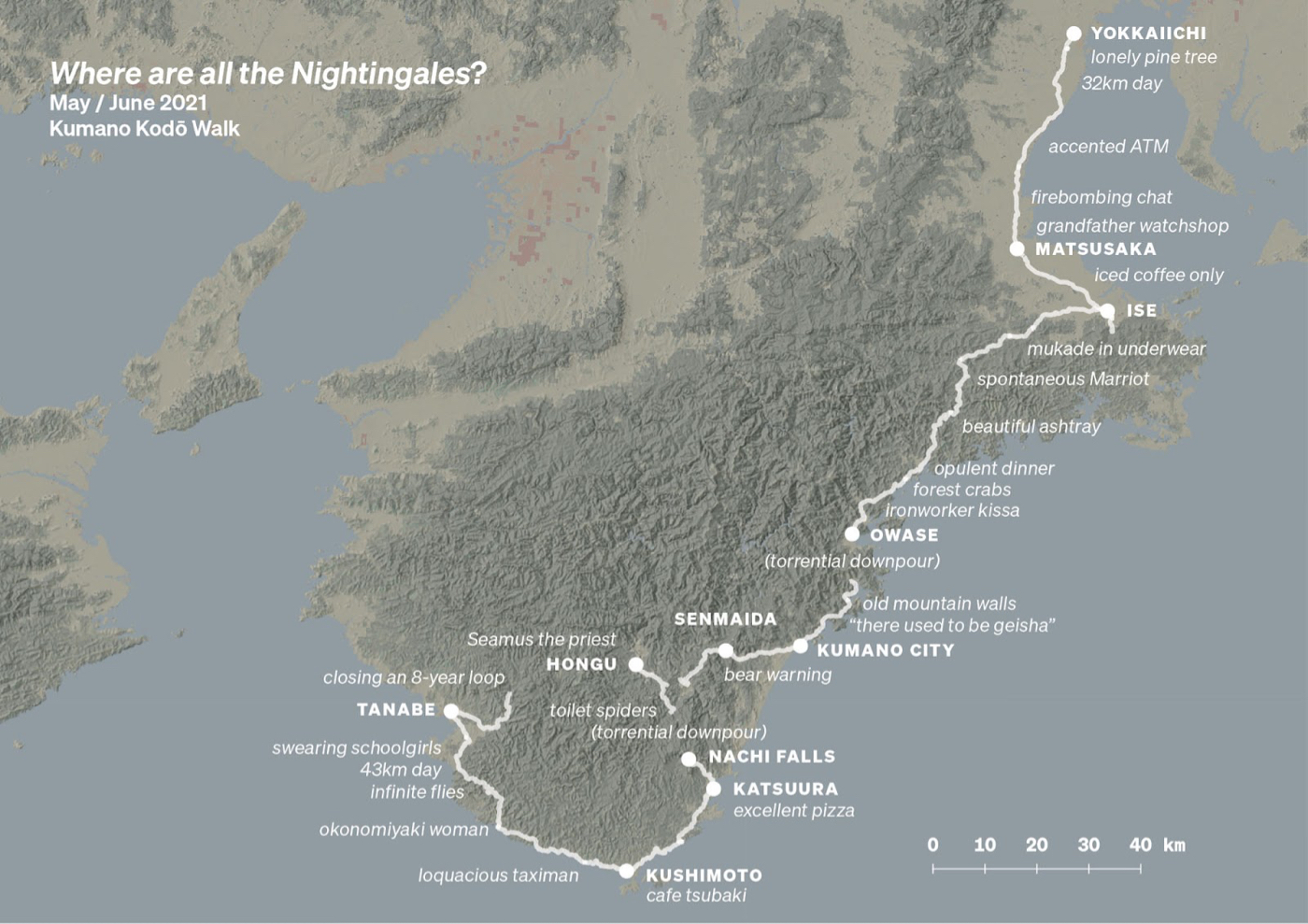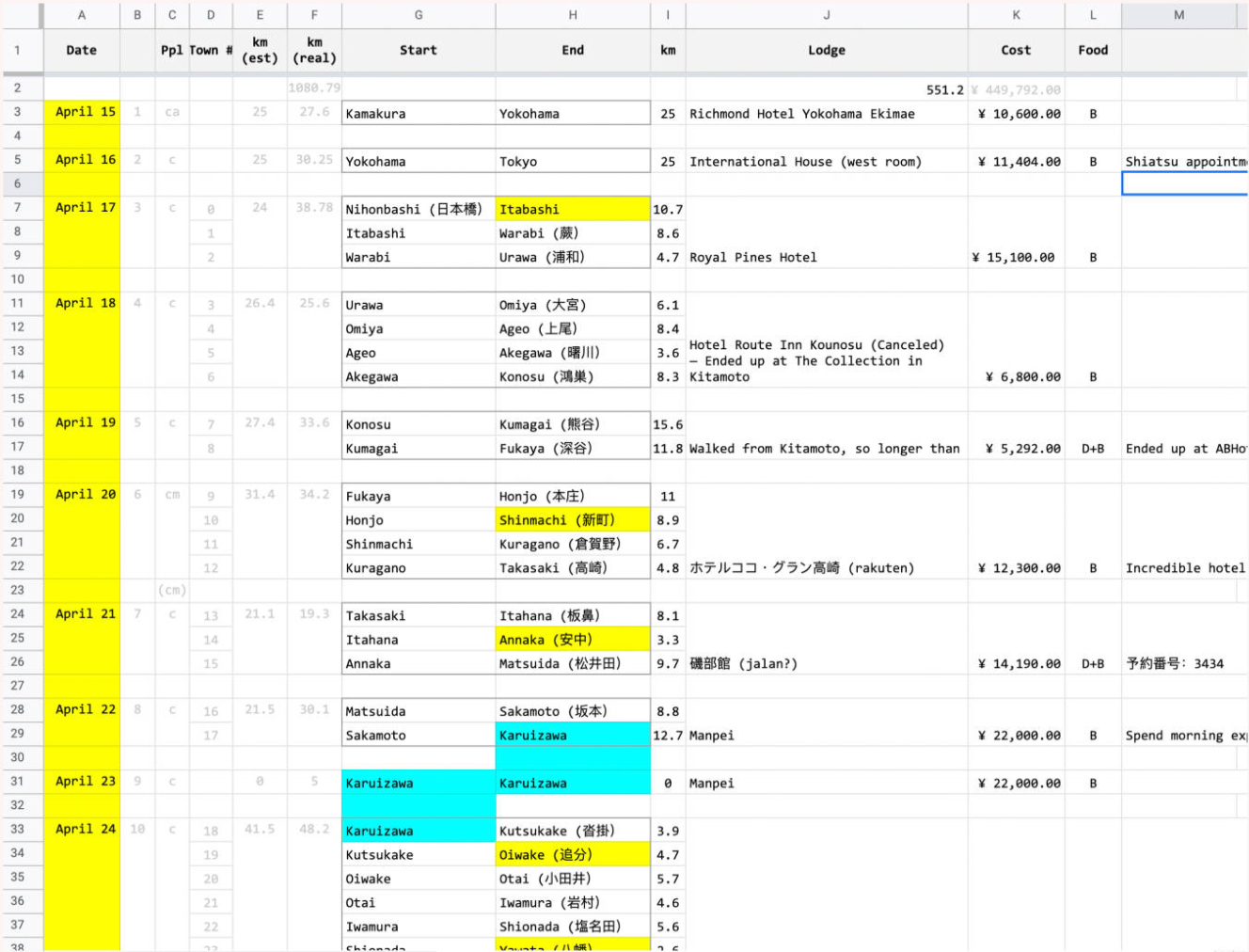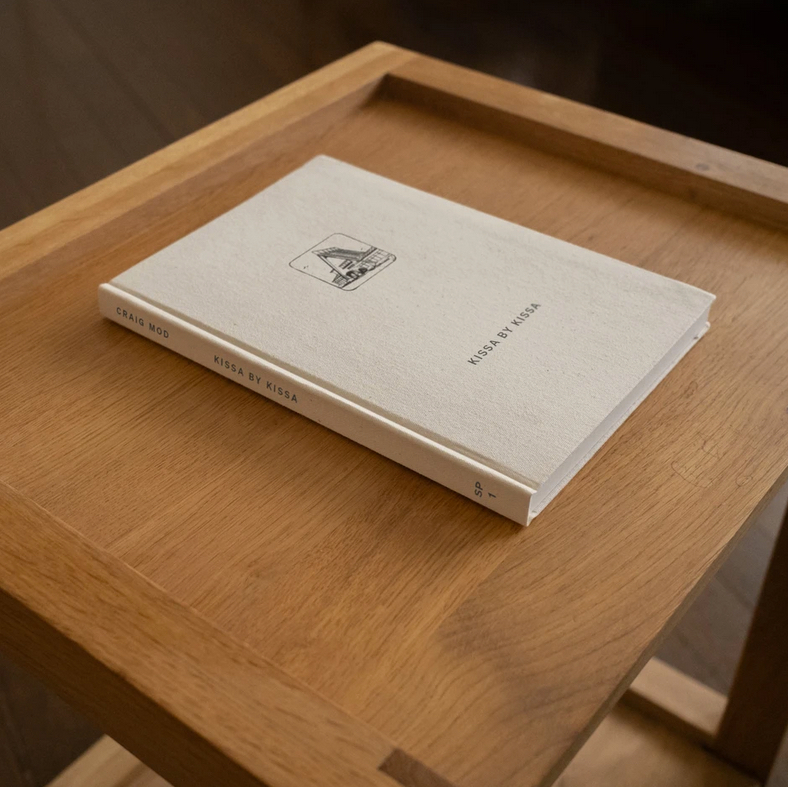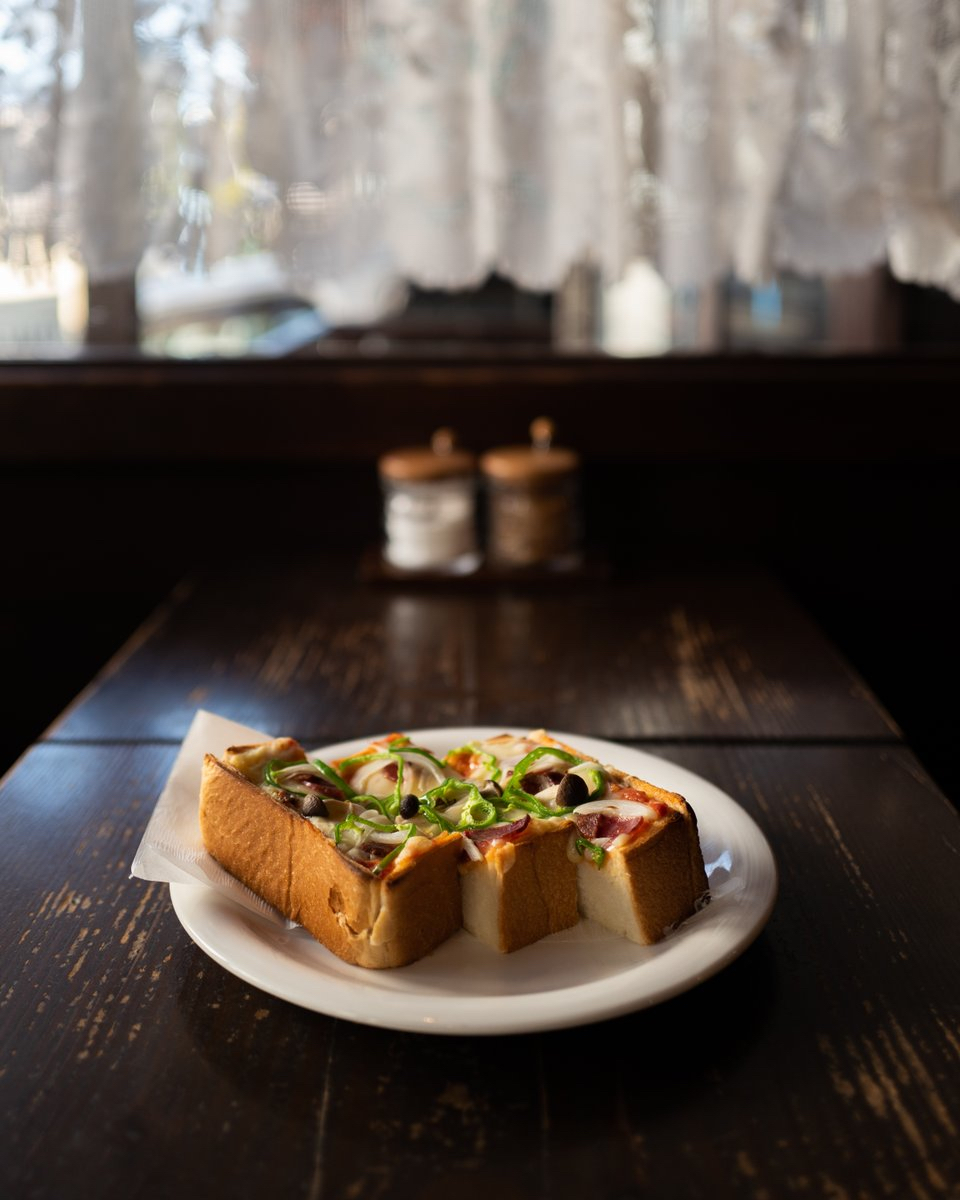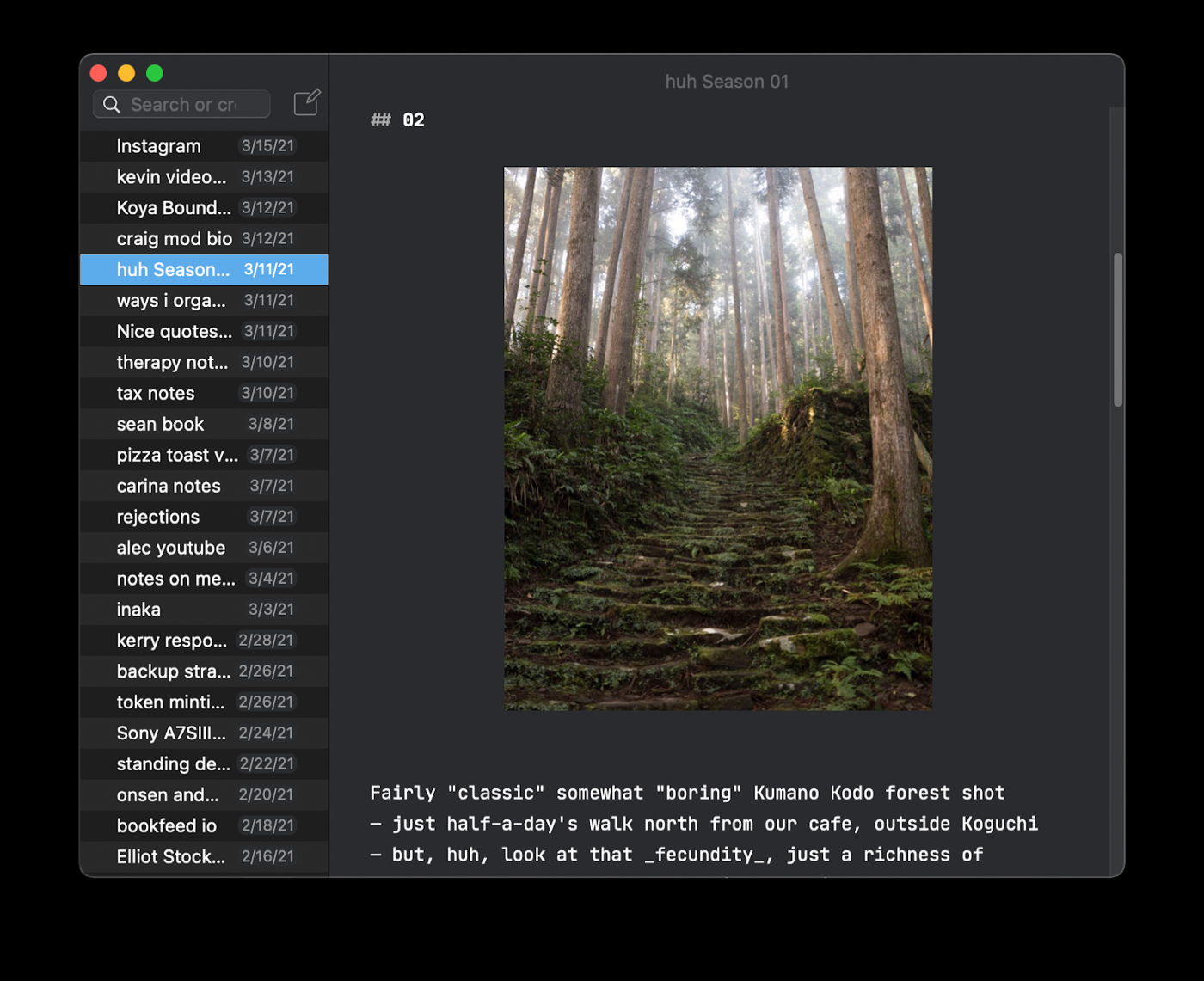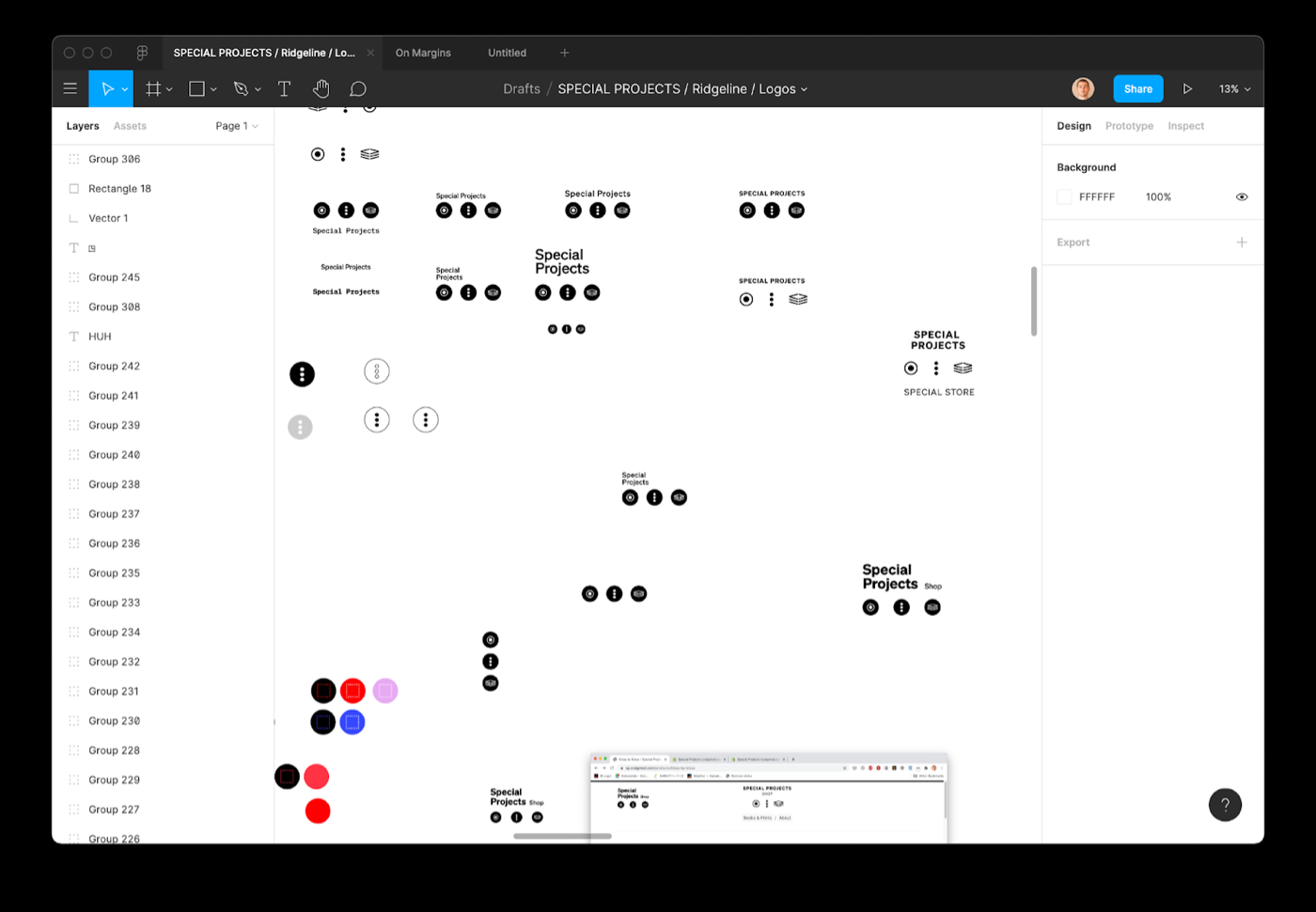Most writers have a system in place to drive the work they do. My own system, for example, is mad and unpredictable, and it’s based on a mysterious alchemy of guilt, panic, dumb luck, and caffeine-induced tweaking.
Craig Mod, on the other hand, has a fascinating (and slightly less neurotic) method for driving his work as a writer: walking.
Craig thinks of a walk as an operating system that he can use to support, feed, and inspire all the basic functions of his writing. Walking gets his mind moving, stimulates his bottomless curiosity, and energizes his creative force.
But it’s more than that: the whole gamut of work Craig does, whether digital, or tangibly, unapologetically analog—is supported by his approach to walking. Both how he writes and what he writes about are inextricably linked to the process, discipline, and experience of putting one foot in front of another.
The results speak for themselves. Craig’s writing has developed an engaged and loyal following over the years—tens of thousands of people read his multiple newsletters, and his work has appeared in publications like Eater, Wired, The New Yorker, and The Atlantic.
His greatest love, though, is making books. It’s the most tangible and soul-satisfying work product of all his walking. The latest is Kissa by Kissa, currently going into its third artisanal printing, and there’s another opus marching towards the presses in September.
So how does Craig transform steps into words, and words into books? Let's take a stroll together to see how walking enables Craig to do what he does.
Want access to 60+ Superorganizers interviews, productivity essays, and the other 10+ newsletter on Every? Subscribe for $1:
Craig Mod introduces himself
When people ask what I do, to keep it simple, I just say I'm a writer and I work on books.
Walking—and walking in Japan—is a core part of my identity
I’ve lived in Japan for most of my adult life, and I went on my first ‘real’ walk here about twenty years ago. I’ve gone on countless big walks around Japan—sometimes with friends and mentors, but more often alone.
Last month, I finished a 435-kilometer walk along a few routes of the Kumano Kodō UNESCO World Heritage pilgrimage trail:
Arriving in the rhythm of a long walk can take a few days, but I find that once I’m there, a momentum takes over—I get a natural high, the mind seems to open up, I become more creative, and I start to truly notice things.
Through walking, I feel like I accidentally discovered a way of more fully interacting with place, and of connecting with people in situations that I would never otherwise get to be in. For example, I spend a lot of my time on these walks talking with farmers, say, or charcoal makers—folks I’d otherwise never bump into in my ‘normal’ life. But in the context of a long walk, our paths naturally converge.
Since my earliest walks, I’ve been investigating what I can do with walks. I like to carry out experiments to see what the experience of the walk might lead me to create or publish, in sounds, images, and words.
I think of my walks as an operating system—a platform for creative work
For me, a walk is a tool or platform upon which I can build, sort of like an operating system. When I become fully immersed in ‘walk mode’ the operating system begins to hum along, becoming almost autonomous, and I find the experience of this incredibly empowering. It just feels like the world and my place within it vibrates at a higher, more finely tuned level.
I realize this sounds somewhat insane, and I suppose that’s true—but a long walk contains within it the act of losing your mind: the long hours, the endless kilometers. On a properly executed long walk, it feels like the world pops from HD to 4K in terms of detail and texture, if that makes any sense.
As I walk throughout the day, I find myself thinking about what I will write that night. And I become absorbed by engaging with the towns and villages I pass through and connecting with the people I meet.
If I’ve ‘programmed’ the operating system well, I’ll get into that elevated state of creativity and rigor.
I program my walks by setting rules
Different walks have different rules, but when I’m on a walk, a typical rule is that I consume no newspapers, articles, or podcasts, and I use no social networks—nothing that could mentally teleport me out of the walk. I use Freedom to block all of this on my laptop and smartphone.
That doesn’t mean I don’t use technology on my walks. Under the rules I made for a walk last year on the historic Tōkaidō road between Tokyo and Kyoto, I produced videos every day, made recordings of ambient sounds on the walk for my SW945 podcast, and wrote and published essays every night.
That meant that after a full day of walking, I had to import gigabytes of data, process audio, process video, export it, get it into a YouTube-friendly format, write and edit a newsletter, then push it through my complicated publishing system.
So even if I felt completely spent, and was certain that I would die if I didn’t get to sleep immediately, the rules I set created an accountability that I took seriously: they said that I had to get all of this done. And because I was in this elevated, ascetic walking mode, I did! I got it all done—even if I was nearly falling asleep at the keyboard.
Of course, when I come to the end of a walk, I'm absolutely zonked and I need a few weeks to recover—but I feel more of a deep-seated sense of being energized and having used my body and mind well, rather than pure exhaustion—and I love working this way.
I use Google Sheets to plan all my walks
Planning a walk on a spreadsheet is a critical part of my process. I take care of all the logistics and planning in advance, so I don’t have to think about the day-to-day. I can be 100% present in the walk. Even choosing a hotel for the next day would occupy too much mental space while in the walk itself. I’d rather that time be spent on photography, writing, synthesis, or recovery.
Here’s the Sheet for my walk on the Nakasendō in 2019. As you can see, each row is a day of walking, with a starting and an end point. Sometimes a day takes up multiple rows, with a row for each town I’ll be passing through. I include an estimated distance of the walk (usually an underestimate!), actual distance once I’ve walked it, and everywhere I’m going to stay. I book all my accommodations in advance—a lot of inns in Japan don’t have websites, and have to be booked with a phone call. This takes ages. I probably spend a dozen hours on the phone and websites mapping out a month of walking.
I keep a record of each inn’s cost, and whether or not meals are included with my lodging. That way I know in advance if I need to make special plans for food. I also have a column for general notes, where I record hotel reviews or keep a record of places of historical interest.
Making these spreadsheets in advance of a walk serves as a kind of forcing function for me, too: with the days ‘set’ in advance, my chances of slacking off in the middle of a particularly rigorous walk are greatly reduced. I try to be kind to myself by keeping the days reasonable, but I know that if I were planning it all in real-time, I’d be much more of a wimp, take much more time off, and be far less rigorous.
My ‘horizon goal’ is to make books
Rather than having a singular set of goals that I try to reach, I have one, main ‘horizon goal’. To stick within the walking metaphors: the horizon is something you’ll never reach, no matter how long you walk—it’s something you keep moving towards.
The horizon goal I’ve been moving towards for the last thirty years is bookmaking. Since I was a kid, I’ve looked at books as work or objects to aspire to, and now, having made some myself, I'm even more inspired by their power.
My latest book is Kissa by Kissa, about my experiences of walking 1000 kilometers of Japanese countryside along the old Nakasendō highway. It sits somewhere between travelogue, photo book, and ethnographic study.
The title refers to ‘kissaten’: small old-style cafés that dot the Japanese countryside and cities. These places often serve some variant on the curiously alluring American-influenced—but uniquely Japanese—pizza toast, which is exactly what it sounds like, as you can see in one of my photos!Kissa by Kissa was produced entirely in Japan. I’m proud of the work that the book gave to the people involved in production—from the paper makers, to the printers and binders. My goal was not to optimize for lowest cost of production, but rather to create an ecosystem feeding back into high-quality, sustainably priced books, produced by well-paid and talented print technicians.
I hope that everything I do supports my horizon goal
Many of my ongoing projects may seem like they have little to do with the production of physical books. But I think of everything I do as a series of experiments that inform the development and content of the books I may make in the future.
For that reason, I try to ensure that the constellation of projects I take on elevates my book work. At the moment, those projects include three separate newsletters, which go out to tens of thousands of subscribers per month. I think of them as my public sketchbooks.
I also produce a podcast called On Margins, made of interviews with folks about ‘book-shaped’ work—people writing books or designing books or publishing books.
My membership program acts as an accelerant for my horizon goal
The most powerful tool I’ve found for helping me achieve my book-making goal is Special Projects, the membership program I started a little over two years ago.
For one thing, the members provide me with a sense of community—a collection of interesting and talented people I can bounce ideas off. They also keep me honest—I try to be accountable to them, which drives me to be the best creative version of myself.
My members help me with planning, too. Earlier this year, I held what I called a ‘board meeting’, where I gave a presentation about what I’m going to produce this year, when, and why. I’ve never been big on granular scheduling, so this was one of the first times in my life that I’ve ever planned a whole year out.
I went through the year month by month, and we discussed making another book based on my walks—the plan is to finish it in mid-summer, launch in August, and go to print in September. I found the process weirdly useful, and it’s something I plan on continuing to run going forward, perhaps on a once-every-six-months schedule.
How I avoid the pitfalls of a membership program
I try to avoid what I think is the scariest part of running a membership program—having it become a gilded cage.
That can happen if, for example, you get good at publishing newsletters, but instead of continuing to write newsletters about subjects you’re interested in, you end up becoming the person who writes about how to write newsletters. You become the meta-version of yourself.
In other words, you end up not doing the stuff you set out to do at the beginning. It’s easy for that to happen, too—it tends to be more profitable (it’s a form of self-help, which is always quite profitable), and it can be easier to grow—but it’s something I’ve always been wary of.
In my case, with Special Projects, I’m lucky that I’ve never felt like I had to make any compromises to get members. Growth has been slow. But over the years, I’ve cultivated a following of people who seem to appreciate the weird tenor of work that I’m doing, and they want to see that continue.
So I don’t offer members-only how-to-run-membership-programs classes, or a book on newsletter writing. Instead, Special Projects has been tied to the creation of well-made, limited-edition books—which is the very thing I’ve wanted to do all along.
I divide my time into chunks to help with focus-shifting
The different things that I do—walking, writing, admin work, keeping up with my members, and actually making books—require some different modes of working. I’ve found that the best way to handle the necessary shifts in focus is to divide my work into chunks. Sometimes those chunks are a few hours or days, and sometimes, those chunks have to be quite big—weeks or months.
When I was doing production work for Kissa by Kissa in 2020, for example, I wasn’t really doing any real creative writing. Instead, there was a two-month period where all I did was think about book production—stuff like paper types, how to develop images depending on the paper, different ways of binding, and how to set up order fulfillment once the book was published.
Obviously, ‘walk mode’ takes up a huge chunk of time. Going on a long walk requires a specific quality of time to give to the work. I chunked out a huge block of time for that month-long walk I did on the old Tōkaidō highway in November last year:
Then, after that walk was over, at the beginning of this year, I decided not to ‘be creative’ until February. Instead, I chunked the whole month of January into catching up on administrative work, as well as writing up some reflections on the past year. I was able to finish off a lot of the tasks that tend to feel like ‘homework’ and are therefore easy to put off. But once that was done, I was free to dive back into more creative spaces.
And when I had made the decision to go on a walk this May and June, I just circled those two months in my calendar, and completely blocked off that chunk of time as well.
Some of the tools I use
I’ve described myself as a ‘mega geek’, and I use a wide array of sometimes onerous tools—which I’m constantly tweaking and refining—to get things done.
For email, I use the Mail app on Mac OS, which I find to be fantastic and reliable. Things is my main to-do organizer. I mainly use the ‘Today’ view, and every night before I go to bed, I’ll set up my next day in there. I also find it useful for postponing things—you can hit Cmd-S and arrow key down to push out a to-do to a later date. So each day, stuff I’ve queued up in advance or pushed out automatically pops into my Today view. It’s a system that has worked well for me. I’ve been using Things for… thirteen years!
I write the drafts of my newsletters and essays in Ulysses, and I use FSNotes as my main note-taking program since I switched to it from NV-alt. I use it for meeting notes, or during my weekly therapy sessions, for example. I also use it for drafting Instagram posts:
I use Figma as a kind of generic sketchbook. I have a giant Figma file for Special Projects—here’s where I try out different typefaces for the branding, and organize and create assets and icons:
I used to work with Figma’s co-founder and CEO Dylan Field ten or eleven years ago, and it’s been fantastic to see that company do as well as it’s done. Dylan’s a great guy and Figma is a great product—it’s essentially an infinitely large canvas for creativity. I’m proud of what they’ve built.
I use the Hugo static site tool to make my homepage—I love having total control over how it looks and feels (though I wouldn’t recommend this to everyone!). Messing around with code is a kind of cheap therapy for me. I also like being able to publish on my own domain, and not being attached to a venture-backed platform that will make me publish or shape my work in ways that aren’t of my own choosing.
I run Memberful as the backend for Special Projects, which is great because it plugs into Campaign Monitor—which I use as my email and newsletter provider—and into Stripe, for payments and payouts. The whole setup is fairly nimble and independent.
I deliberately set up forcing functions for myself
A creative person—a novelist, say—who writes a lot and publishes a new novel every couple of years is someone who probably has a system that makes words come out. They’re either naturally good at creating that system themselves, or they rely upon some external motivator they’ve set up.
One example is the author Karl Ove Knausgård, who has had a massive output in terms of words written and published. His forcing function in writing his multi-volume My Struggle was to get on the phone with his editor daily and read him everything he’d written that day. Accountability leads to productivity.
For me, newsletters are my forcing function. Whether I’m at home or in the middle of a walk, writing newsletters forces me to look back on what I’ve done, seen, and thought about over the last week or month.
By having set deadlines as part of my day-to-day, I find that I produce more.
I even use Japan’s weather as a forcing function: I would have preferred to wait a bit longer before going on the walk I did this past May and June, but I had to get it done before the monsoon season began. Otherwise, I would have had to wait until November or December—and I want to be setting out on yet another walk then!
When it comes to creative work, the more you do the better
If you're trying to write an 80,000 word novel and you only write 80,000 words, it might be acceptable. But if you wrote 300,000 or 400,000 words and cut that back to 80,000, it’s almost certain that it would be a better novel.
Kissa by Kissa is one example. It only has 12,000 or 13,000 words in it, even though I wrote more than ten times that amount. That’s an interesting kind of reduction: basically a tenth of what I wrote became that book. To me, that feels like a durable ratio.
The last two or three years have been the most productive of my life. I feel that I’ve been honest with my own impulses—I’ve spent time in a way that feels very much aligned with how I hope to spend it. It feels as if time itself and my place within time are being respected. And because of the sheer output of work I have to show for it, I think I’ll be able to look back on this period of my life and not feel like I burned it twiddling my thumbs.
Massive scale alone doesn’t excite me
Back when I was working in Silicon Valley, I worked on software that was used by tens of millions of people—and I was kind of shocked to discover how little of an emotional impact that level of scale had on me.
I have nothing against mammoth scale in and of itself, but to me, doing something ‘big’ just for the sake of ‘big’ isn't interesting. I’m simply not interested in working on a newsletter that has 300,000 subscribers if I’m not passionately ensorcelled by what the newsletter is about.
Not that I’d turn up my nose at a chance, for example, to work on a book with a big New York publisher! But it would have to be a project that got the publisher excited, while also being fully aligned with my interests. I’m all for ways of working that enable me to reach a bigger audience while also staying true to my creative goals.
For me, there’s a happiness cutoff line when it comes to scale. Do I want to be operating on a micro scale of tens of people? No, but the scale at which I’m producing books right now—thousands or tens of thousands—feels like a powerful one. It’s financially sustainable, reaches a decently-sized audience, and I don’t have to compromise on my vision.
I’m very thankful to everyone who supports my work. I feel extremely grateful to have the audience that I do, and be able to produce work at this level—it's fantastic.
A book recommendation
I'm in the middle of reading The Ministry For The Future by Kim Stanley Robinson on Kindle.
The book is set in a fuzzy near-future, maybe fifteen or twenty years down the road. The author speculates about some of the potential effects of climate change, as well as some possible mitigation efforts. It's very wonky, with a lot of technical information about climate change and its political and organizational aspects.
The author could simply have written a bunch of essays about climate change and why our institutional structures keep us from passing meaningful legislation to combat it. Instead, he does an amazing job of incorporating those elements into the swirl of a story to make us feel—on an emotional level—what the world faces if we don’t take action. He casts the banal in well-crafted myth, and from that, one hopes, action will be inspired.
That’s the real power of writing!

